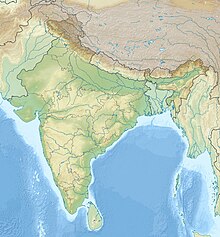Sridharavarman
| Sridharavarman | |
|---|---|
| General, Great Satrap and King | |
| Reign | Circa 339-368 CE |
Sridharavarman (Gupta script: ![]()
![]()
![]()
![]()
![]()
![]() , Shridharavarmmana, ruled circa 339-368 CE)[1] was a Saka (Gupta script:
, Shridharavarmmana, ruled circa 339-368 CE)[1] was a Saka (Gupta script: ![]()
![]() , Śaka, Indo-Scythian) ruler of Central India, around the areas of Vidisa, Sanchi and Eran in the 4th century CE.[1] He calls himself a general and "righteous conqueror" (dharmaviyagi mahadandanayaka) in an inscription, and "Rajan" ('King") and "Mahaksatrapa" ("Great Satrap") in a probably later inscription at Eran, suggesting that he may have been a high-ranked officer who later rose to the rank of a King.[2]
, Śaka, Indo-Scythian) ruler of Central India, around the areas of Vidisa, Sanchi and Eran in the 4th century CE.[1] He calls himself a general and "righteous conqueror" (dharmaviyagi mahadandanayaka) in an inscription, and "Rajan" ('King") and "Mahaksatrapa" ("Great Satrap") in a probably later inscription at Eran, suggesting that he may have been a high-ranked officer who later rose to the rank of a King.[2]
Inscriptions


Kanakerha inscription
Sridharavarman is known from two inscriptions: the first one is the Kanakerha inscription at Sanchi.
Eran inscription
Another inscription of the same Sridhavarman with his Naga military commander is known from Eran.[1] At Eran, it seems that his inscription is succeded by a monument and an inscription by Gupta Empire Samudragupta (r.336-380 CE), established "for the sake of augmenting his fame", who may therefore have ousted Sridharavarman in his campaigns to the West.[3]
The Eran inscription reads:
Success! In the victorious twenty-seventh year, augmenting [his dominion for a thousand years] of the Rajan (and) Mahakshatrapa Sridharavarman, the son of the Saka Nanda —the righteous conqueror, who has obtained abundant fame by means of victories won by his valour, [who meditates on the feet of the divine Mahasena whose army has never been vanquished] on this day (namely) ..... in the adhishthana (town) of Erikina in Bahirika in this ahara of Nagendra, a flight of steps [at the river Venva] [has been caused to be constructed] with devotion by [Nara]yanasvamin for the well-being of the adhishthana headed by the cows and the Brahmanas, (and) for the increase [of the religious merit of his mother and father].
[At the same adhishthana in his own bhoga there has been erected this yashti] by Satyanaga, the Senapati (General) and Arakshika of the King, who is a native of Maharashtra and is foremost of .... for the removal of calamities, for the attainment of prosperity and for the happiness and well-being of all creatures.
Moreover-
While (our) King is ruling over the wide earth ..... may this yashti, (raised) by the Nagas themselves, remaininf unimpaired, proclaim by its form the duty of the warlike people...; for this is the (meeting) place of (all) people - friends as well as foes - in (a spririt of) service and reverence!
— Translation by Yasudev Vishnu Mirashi[4]
Connected rulers
While the Western Satrap Rudrasimha II ruled in the western India, the Gupta Emperor Samudragupta may have ousted Sridharavarman during his campaigns in Central India.[3]
-
Rudrasimha II ruled the Western Satraps at the time of Sridharavarman.
-
Samudragupta ruled in the East at the time of Sridharavarman.
References
- ^ a b c Buddhist Landscapes in Central India: Sanchi Hill and Archaeologies of Religious and Social Change, c. Third Century BC to Fifth Century AD, Julia Shaw, Routledge, 2016 p58-59
- ^ Mirashi, Vasudev Vishnu (1955). Corpus inscriptionum indicarum vol.4 pt.2 Inscriptions of the Kalachuri Chedi Era. Archaeological Society of India. pp. 605–611.
- ^ a b "During the course of this expedition he is believed to have attacked and defeated the Saka Chief Shridhar Varman, ruling over Eran-Vidisha region. He then annexed the area and erected a monument at Eran (modern Sagar District) "for the sake cf augmenting his fame"." in Pradesh (India), Madhya; Krishnan, V. S. (1982). Madhya Pradesh: District Gazetteers. Government Central Press. p. 28.
- ^ Mirashi, Vasudev Vishnu (1955). Corpus inscriptionum indicarum vol.4 pt.2 Inscriptions of the Kalachuri Chedi Era. pp. 610–611.



